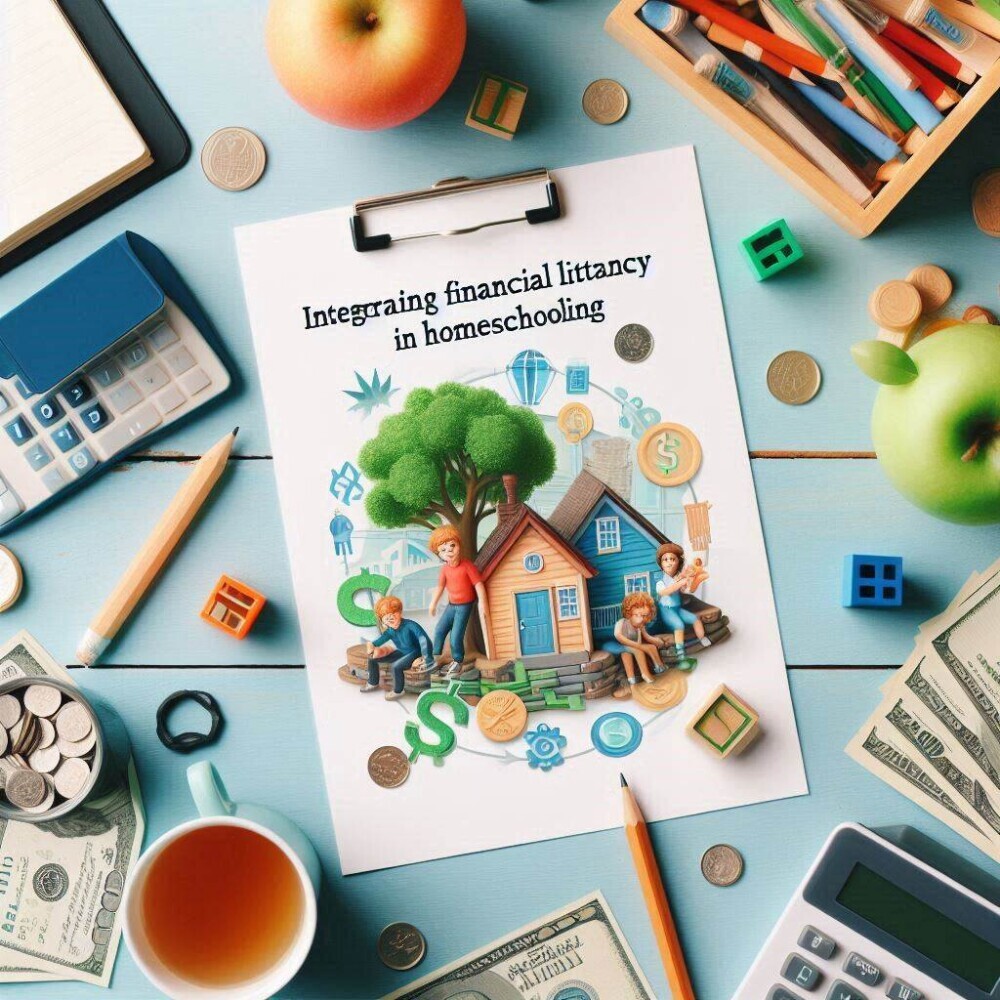Introduction
Integrating financial literacy into your homeschool plan is one of the smartest choices you can make. Teaching kids about money at home builds real-world skills they’ll use for a lifetime. I’ve found that weaving money habits into everyday routines not only makes math lessons more meaningful, but it also sets kids up for independence and confidence.
This guide shows how integrating financial literacy can fit naturally into homeschool life. I’ll share why it matters, practical steps, favorite tips, and some go-to resources to keep it fun and doable for families just starting, or looking to take their money lessons up a notch.
This post may contain affiliate links. When you click and purchase from any of our links, we may get a small commission at no extra cost to you. For more information, please see our affiliate disclosure.
Why Integrating Financial Literacy at Home Matters
Integrating financial literacy helps build skills that textbooks alone don’t always cover. When I started homeschooling, I noticed how often kids hear adults talk about money but rarely get hands-on experience with it. School curriculums might touch on the basics, but real understanding sticks better when kids see, touch, and make decisions with money themselves.
In my own home, I’ve seen that when kids can handle actual coins, make simple budgets, or track savings, it connects money lessons to daily life. This builds their confidence around spending, saving, and even mistakes; because it’s all part of learning. Homeschooling makes it easy for parents to turn these lessons into activities that feel natural and fun, not forced or stressful.
Starting Early: Laying a Foundation for Smart Money Moves
Kids start forming ideas about money younger than you might think. Even my youngest was already interested in how “allowance” worked long before understanding place value in math. That natural curiosity is the perfect place to begin with financial literacy. Early lessons can be simple; matching coins, sorting bills, or playing imaginary store. This builds comfort before the formal money talks even begin.
One routine I use involves talking about needs versus wants during grocery runs. I’ll ask, “Do we need this, or is it just something we want right now?” These mini-conversations help shape how my kids think about spending. Other times, we’ll count change from a piggy bank together, or set a small savings goal for a favorite toy. Little steps turn money from an abstract idea into a useful tool.
Practical Activities for Young Learners
- Use play money to “shop” at home. Set up a pretend store and give each child a set amount to spend.
- Count coins and group bills by value and color; kids enjoy seeing and touching real money.
- Start a simple savings jar for family outings, letting the kids drop in spare change to watch it grow.
Integrating Financial Literacy Into Everyday Homeschool Lessons
Money skills aren’t just for math time. Integrating financial literacy works best when it’s part of lots of subjects and family routines. For example, in our homeschool, I’ll introduce word problems about budgeting or include money conversations during history lessons about trade and markets. Even science has a role; think about the costs of running experiments or “selling” projects at a homemade science fair.
One way I blend it all together is with real-life scenarios. For instance, giving the kids $20 (real or pretend) and asking, “How would you plan a meal for four people?” They get to research, compare prices, and make choices. These are the same steps they’ll use as adults, just in a safe, supportive space.
Homeschool Projects That Teach Money Skills
- Host a family market day. Kids can make crafts or snacks, set prices, and “sell” to siblings or parents.
- Plan a small event, like a lemonade stand, and track expenses versus money earned.
- Set up a classroom budget for homeschool supplies. Let the kids help pick what to buy, considering price, need, and quality.
- Create a family store with rewards for good work or positive behavior, so kids can “buy” privileges or small treats using earned tokens or play money.
Handling Allowances and Chores: Learning by Doing
Giving kids their own money to manage is probably the most direct way to teach financial responsibility. In our home, we use a basic allowance system tied to certain chores. It’s nothing fancy, just a few dollars a week for consistent effort. What I love is watching the learning happen naturally. Sometimes my kids blow all their money on candy; other weeks, they save for months to buy something big. Either way, they see the consequences of their choices.
When questions come up (and they always do), I try to step back and let them work it out. That might mean dealing with regret after spending too quickly, or feeling proud for saving a long time. These lessons stick far longer than any lecture I could give. Plus, letting siblings negotiate trades or split costs teaches teamwork, compromise, and even a little negotiation.
Smart Tips for Managing Allowances at Home
- Decide as a family how allowance will be earned; some tie it to chores, others offer it as a regular “money lesson.”
- Encourage basic budgeting: save a little, spend a little, and give a little to help others.
- Talk openly about mistakes. Share times when you spent too much, or saved up for something really special. Your experiences make it real for them.
Integrating Financial Literacy With Technology and Games
Tech can turn dry money lessons into something much more engaging. There are lots of apps and online games that teach saving, spending, and even investing basics, all in a format kids really want to use. I’ve seen that using a mix of physical money and digital tools helps kids connect old-school and modern money management.
Some of my favorite resources include money board games like Monopoly Junior or The Game of Life. There are also many free online sites where kids can “run a business,” check out economic principles, or play budgeting games that show real-world cause and effect.
Simple Tech Ideas for Homeschool
- Try money management apps designed for families; many of these let kids “bank” allowance, set goals, and watch their progress.
- Use spreadsheet basics for older kids, tracking chores, savings, or even make-believe investments as a homeschool math project.
- Explore free online budgeting and shopping simulators that focus on practical life skills. A fun idea is to challenge kids to beat their own “best deal” score each week.
Talking Money Values and Family Culture
Money isn’t just math. It’s also about values, choices, and personal ethics. Each family has a slightly different style when it comes to spending, giving, and saving. One thing I really focus on is making financial conversations open—not secret or high-pressure. When kids see you talk about money calmly and honestly, they learn it’s okay to ask questions or admit they don’t get something yet.
At our house, we often talk about generosity in addition to budgeting. Decisions about giving; whether it’s donating to a cause, tithing, or helping a friend, open up great discussions about what matters most. These conversations don’t need to be heavy. Sometimes it’s as simple as “How much would you like to give from your allowance this week?” or “What do you think is a fair price for this service?” Over time, this grows a healthy relationship with money that goes beyond dollars and cents.
Building Meaningful Money Conversations
- Involve kids in basic family budgeting (age-appropriate, of course) so money isn’t a mystery.
- Ask for their thoughts on big purchases or family outings; should we save for a weekend trip or put the money toward new books?
- Respect their choices, even if you disagree. It helps them develop ownership and trust in their financial decisions.
Overcoming Common Financial Literacy Challenges in Homeschooling
No plan is perfect, and real life always throws in some twists. There have been times when getting my kids interested in a savings goal felt almost impossible. Other days, life got busy and we totally forgot to do “money lessons.” The key is flexibility, being willing to switch up methods until something clicks.
When progress feels slow, I remind myself that every little experience builds a foundation. Maybe your child finally decides to save for weeks, or comes up with their own idea for earning money. Celebrate those moments! Sometimes a fun challenge or family competition, like “Who can find the best deal at the store?” brings fresh energy when interest starts dropping.
Homeschool groups are super helpful, too. Sharing successes and struggles with other parents can spark new ideas or encourage you to keep going. There are also supportive forums and blogs full of tips from parents who’ve been there, which can save a ton of trial and error along the way.
If your family has children of various ages, try letting older siblings help teach younger ones about handling money, or work together on a family project. Peer learning is surprisingly effective and builds confidence in everyone.
Final Thoughts
Integrating financial literacy into homeschool life goes way beyond weekly chores or math drills. It’s about prepping kids to make smart money choices, handle setbacks, and grow into confident, capable adults. Every coin counted, every mini-budget, and every family conversation gets them closer to that goal. The best part is how flexible and creative you can be. Money lessons fit into just about any subject or daily routine. As your kids grow, so will their understanding, and before you know it, you’ll see them making smart money moves on their own, maybe even surprising you with their creativity or self-discipline.
Additional Resources
- Article – Creating Your Own Unit Studies: A Powerful Way To Learn
- Resources – Homeschooling supplies and project ideas available online
When you click and purchase from any of our links, we may get a small commission at no extra cost to you. For more information, please see our affiliate disclosure.

